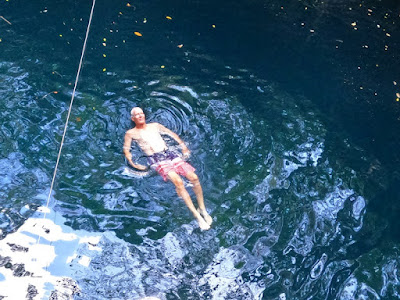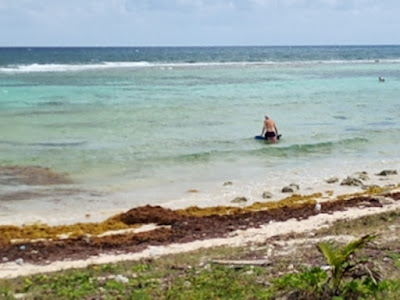Once we left Merida for good, we found this beachside road to camp at. How can you complain about the view we had all to ourselve?
We headed south out of Merida and took a side road out to this old ruin of a huge hacienda--Hacienda Cacao. The plantation owner made a fortune back in the early 1900's from henequen, aka sisal. Ropes, clothes, baskets, etc. were woven from the fibers they got from a variety of the agave cactus. The owner must've been well-to-do as he had a car; the rusted hulk of it still sits on the grounds here.
The old smoke stack is leaning but still standing.
Amazing tree roots take hold of any solid surface.
We were only a few kilometers from a couple of cenotes, so we carried on down the dirt road to reach them. We paid $300 MXP to access these two cenotes. This is Dzonbakal, formed when a roof of limestone collapsed into the underground water system and created this cave we could access.
The color of the water in these cenotes/sink holes in karst is incredible! And so clear.
We donned our snorkels and masks to look into the deeper blue of the back of the cave/cenote.
Karen floating in the cenote. Cool, clear water made for a refreshing way to spend the morning. And we had the place to ourselves!
The second cenote we visited was X'Batun, another gorgeous setting for us to take a dip in. This one had 1/3 of the surface covered in lily pads. The little minnows and catfish swam with us in the shallows. Gorgeous.
The cave walls and ceiling are still visible as the edges of the water-filled cave. The cenotes are part of an extensive underwater fresh water system here.
Jsaon snorkeling in X'batun. He found me a gold hoop earring--treasure!
We'd heard of a free cenote the locals used, but without cell coverage, we couldn't find it on our own. We stopped and asked some locals in the vicinity. With our limited Spanish and lots of hand gestures and words we didn't understand, we found our way to the cenote known as Amtum. We parked the van down the road at an intersection and walked the 1/4 mile to the trail to this blue hole. When we got there, we found a group of young men having a picnic and swimming. This guy jumped off the top edge of the cenote wall as we walked up, about a 15-20' drop to the water.
Jason and I entered from the wooden stairs. Jason diving in for a refreshing dip. The bottom step was very slippery and it took some effort to get out onto it.
A relxing pose from Jason.
Karen after diving in as well. There were two lines strung across the water for people to hang onto. You could pull yourself across the water or just sit or hang onto the lines for a lazy time.
Karen resting on the line in the cenote.
The guys we found when we reached the Amtum cenote. They didn't even know it had a name. They shared a couple of beers with us and carried on with their fun.
Looking back at the cenote from another ledge as we left. You can see the stairs we used to get into/out of the water, This is a pretty big cenote, about 85' deep and the only one we knew of that was free of charge to enjoy. A real blue beauty, this one.
We parked on the sandy shore near the lighthouse for the first couple of nights. This was our view. We were so close to the ocean, we got salt spray on us as it was pretty breezy here. Nice to keep us cool, but hard on everything else since we didn't have a way to wash or rinse it off.
The big letters of Mahahual are a photo op for locals and tourists alike. The parking lot would fill up during the day and buses and taxis lined the road for blocks. Even more traffic when cruise ships were in.
The sargassum was blowing onto the shore here. It was piling up fast but hadn't yet begun to decay and stink. This conveyor belt had been used to try to get the stuff off the tourist swimming beach, but was soon abandoned as too inefficient. Men with pitchforks and wheelbarrows went at the stuff all day long. Front loaders and dump trucks carried away the huge piles as fast as they could.
A cute statue outside a back street shop.
The colors from the shore are a pretty rainbow of blues and greens. We think this is pretty spectacular scenery for our stay here.
Most swimmers went into the water between the lighthouse and the pier. Jason took a dip, walking in over the sargassum on the rocky shore here. It looks like sand, but is limestone with some jagged edges you need shoes to cross. He threw his Crocs back to me once he was in and I brought them back to him when he came out.
These two spearfishermen parked next to us and were gone for hours. Here, they clean their fish and toss the guts into the sargassum on the shore. The frigate birds and seagulls cleaned it up pretty quickly, but you can see how fast the sargassum is piling up, too.
Sonny showed up after we'd moved to a better spot a bit farther down the road away from the lighthouse. It was flat and didn't get the salt spray or tourists or traffic. The road dead ended at a hotel construction site people weren't allowed to go into. He parked next to us and set up his canopy for shade.
Sonny and Jason discussing travel info about the upcoming countries. He'd done a ton of research and shared it all with us. Those MSU guys stick together.
We'd never heard of Mahahual, but it is apparently a popular cruise ship port on the Costa Maya in southeastern Mexico. This ship makes a nice photo op with the setting sun. We heard there can be 3-4 cruise ships in port on the same day, but thankfully, they don't come every day. It was so windy when we were there, that we saw two ships circle for hours and then leave without stopping as it was too windy to dock safely.
YOLO and Sonny Travel Adventure vehicles. The guys were comparing noise levels of the generators. Oh, the excitement!
We met Alen and Sara and their 1979 campervan, GreyBird our second morning in Mahahual. We warned them about the sea spray where we'd been parked and the next morning, they came down the road to join us. The loud music from the stage set up for Easter holiday shows also had blasted them until 5 AM and they had to leave, so they joined us down the road on our flat spot. Their old RV had some problems and Jason spent the day helping them diagnose and fix some issues. They bought us two2 6-packs of beer as a thank you.
Our view from the new spot down the road. We ended up staying here for a week and a half over Easter. Town was crowded on cruise ship days and the weekend when locals came from all over to the shore here. Not many came down the dirt shore road to where we were camped, though.
The three of us shared what we thought was the best place around! Secluded, quiet, flat, free, and across the road from a beautiful ocean that supplied a breeze to keep us all cool.
All that fixing tuckered Jason out. He just lays on the floor and snoozes.
Alen wanted to try his hand at fishing from the shore and had an extra rod and reel, so I went with him. The rocks on the shore here are jagged sharp karst limestone and tough to stand on in Crocs as I could feel the sharp edges digging into my feet, making it a challenge just to stand on them. The wind and waves were against us, making it tough to cast out far enough to bother with and. Afraid I'd lose his lure to a sharp edge, I gave up quickly. He didn't have any luck either.
Sara and Alen next to their RV in Mahahual. They were new to traveling, came from Canada and were glad to listen to our stories and advice. With a leaky RV, they won't head too far into Central America before turning back for dry Baja.
Once we finally left Mahahual, we decided to stop and see the Bacalar Lagoon, touted as the Lagoon of Seven Colors. It's white limestone bed lets the gradient colors of the water come through as the depth changes. This is the fort at Bacalar, across from the lakeshore.
It was a chore to find public access to the lagoon as it has all been built up and privatized. You can see some of the colors here from the fort, but I think our site at Mahahual was prettier.
A cute sign in the park above the lagoon.
Another view of the pretty blues and greens that show up. There were lots of boats on this lagoon, too, and the far shore seemed to attract a lot of folks.
Alen enjoyin a marquesita, a crepe spread with Nutella and cheese and rolled up. I had a taste and can vouch for their yumminess, but I never got one.
The public access dock at Bacalar. Not a lot of care goes into it.
A sailboat glides by in front of the public access dock. It was very shallow for a very long ways out.

.jpg)


.jpg)




















































No comments:
Post a Comment